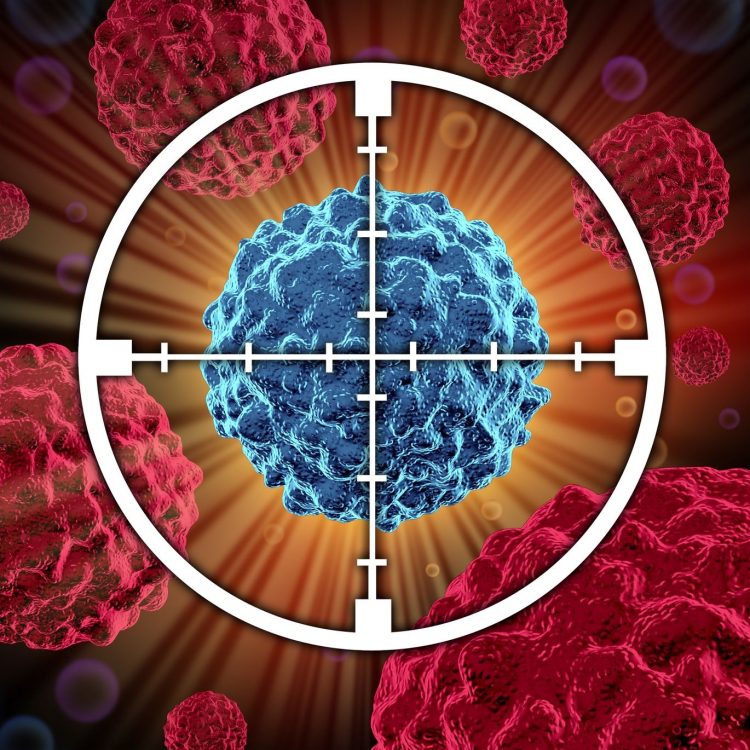A new potential biomarker for cancer imaging

Copyright : lightwise via 123rf
In the paper, an international team reviewed studies conducted over the past 30 years on a particular tracer, called “18F-FLT,” and found that it has the potential to improve diagnostic imaging, and thus treatment, of some cancers.
One way that tumours are diagnosed is by using a radioisotope-labelled tracer that is injected into the body and taken up by cancer cells. Those areas are then highlighted in positron emission tomography (PET) scans.
The biomarker most often used for these scans is a radioactive glucose compound: (18F) fluoro-2-deoxy-D-glucose (18F-FDG). However, this tracer can produce false positives when taken up by normal cells, or false negatives when not enough is taken up to capture the true extent of a cancer.
Another, newer biomarker, (18F)-3’-fluoro-3’-deoxythymidine (18F-FLT), shows promise for specifically targeting proliferating cells. Several studies have found it is less likely to be taken up by inflamed tissue or benign cancer cells, thereby improving the accuracy of cancer diagnostics.
“It is well accepted that 18F-FDG is the ubiquitous marker in PET oncological practice. Nevertheless, 18F-FLT is an exciting marker with improved specificity that could be the number one candidate for therapeutic monitoring,” wrote the lead author, Hassan Hishar, of the Universiti Putra Malaysia.
The 18F-FLT tracer combines a sugar and thymine, one of the four main components of DNA. The compound is incorporated into DNA when a particular gene (TK1) is active, and that gene is much more active in malignant tumours.
18F-FLT has proved better than the more common biomarker, 18F-FDG, in revealing a variety of cancers, including bone marrow, pancreatic and lung cancer. However, it is unclear how well it works for breast and brain cancer, and studies have found it is less effective at detecting colorectal and melanoma cancer.
The team recommends further research to better understand the potential of 18F-FLT in cancer imaging.
For more information about each research, please contact:
Hassan Hishar
Centre for Diagnostic Nuclear Imaging,
Universiti Putra Malaysia
43400 Serdang, Selangor, Malaysia
Email: hishar.hassan@gmail.com
Tel: +(603) 8947 1641; Mobile: +(6012) 270 7486.
About Pertanika Journal of Science & Technology (JST)
Pertanika Journal of Science & Technology (JST) is published by Universiti Putra Malaysia in English and is open to authors around the world regardless of nationality. Currently, it is published twice a year in January and July. Other Pertanika series include Pertanika Journal of Tropical Agricultural Science (JTAS), and Pertanika Journal of Social Sciences & Humanities (JSSH).
Pertanika Journal of Science & Technology aims to provide a forum for high quality research related to science and engineering research. Areas relevant to the scope of the journal include: bioinformatics, bioscience, biotechnology and bio-molecular sciences, chemistry, computer science, ecology, engineering, engineering design, environmental control and management, mathematics and statistics, medicine and health sciences, nanotechnology, physics, safety and emergency management, and related fields of study.
Website: http://www.pertanika.upm.edu.my/
The paper is available from this link:
http://www.pertanika.upm.edu.my/Pertanika%20PAPERS/JST%20Vol.%2024%20(1)%20Jan.%202016/03%20JST-0544-2015%20Rev1-%20Hishar%20Hassanr-Review%20Paper.pdf
For more information about the journal, contact:
The Chief Executive Editor (UPM Journals)
Head, Journal Division, UPM Press
Office of the Deputy Vice Chancellor (R&I)
IDEA Tower 2, UPM-MDTC Technology Centre
Universiti Putra Malaysia
43400 Serdang, Selangor
Malaysia.
Phone: +(603) 8947 1622 | +(6016) 217 4050
Email: nayan@upm.my
Date of Release: 29 January 2016.
Acknowledgements
The Chief Executive Editor, UPM Journals
Associated links
Original research paper
The Pertanika Journal of Science & Technology website
Media Contact
More Information:
http://www.researchsea.comAll latest news from the category: Life Sciences and Chemistry
Articles and reports from the Life Sciences and chemistry area deal with applied and basic research into modern biology, chemistry and human medicine.
Valuable information can be found on a range of life sciences fields including bacteriology, biochemistry, bionics, bioinformatics, biophysics, biotechnology, genetics, geobotany, human biology, marine biology, microbiology, molecular biology, cellular biology, zoology, bioinorganic chemistry, microchemistry and environmental chemistry.
Newest articles

Properties of new materials for microchips
… can now be measured well. Reseachers of Delft University of Technology demonstrated measuring performance properties of ultrathin silicon membranes. Making ever smaller and more powerful chips requires new ultrathin…

Floating solar’s potential
… to support sustainable development by addressing climate, water, and energy goals holistically. A new study published this week in Nature Energy raises the potential for floating solar photovoltaics (FPV)…

Skyrmions move at record speeds
… a step towards the computing of the future. An international research team led by scientists from the CNRS1 has discovered that the magnetic nanobubbles2 known as skyrmions can be…





















